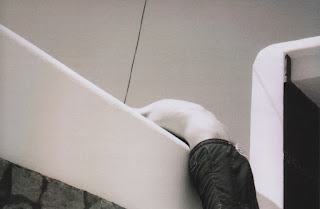Scanning myself really drew attention to the two extremes of accuracy and inaccuracy than can be achieved when scanning a three dimensional form. The images hold a surreal quality, given by the short focal length of the scanner. To advance from what I've done over the last couple of days today I plan to use scans of individual parts of the body to build up an image of an artificial figure.
Through my work I am hoping to question the structure of society's views on the human figure by investigating the difference between nudity and nakedness. Physically and visually these two states may be exactly the same, however the intent, concept and conscious states - of the artist, model or viewer - are arguably very different. If you look up the definitions of the two words there is a distinct difference. 'Naked' not only means to be without clothes (or usual covering or protection), and being undisguised, but it also expresses an exposure to harm and vulnerability. The definition of 'nude' on the other hand refers more to the depiction of the bare human form in an artistic context ("a naked human figure, typically as the subject of a painting, sculpture or photograph"/ "depicting or performed by naked people"). The fact that the definition of nude that I found used the word "naked" suggests that nudity is a form of nakedness with artistic intent. So what does it then mean to simply be naked?
Freya Jobbins is an Australian sculptor and print maker who primarily uses discarded childrens' toys to assemble busts and portraits, exploring the relationship between consumerism and the culture of up-cycling and recycling. Jobbins arranges the parts of the toys in such a way that the expressions and body language the sculptures posses can be quite particular. I am really interested in the process of creating a humanoid sort of nude figure with images of inexplicit parts of the body. The fact that the parts of the body which the figure is made up of are not explicit should, in a literal sense, mean that the figure isn't nude, however, if I create all the visible forms of the nude figure, is it then nude? Is it naked?
I think it's interesting that traditionally we would think of 'a nude' as a figurative artwork, whether that be painted, sculptural or in the form of a photographic print, and that although some of these may have been somewhat erotic, and perhaps shocking at the time they were made, but generally they are not frowned upon. However, the accessibility of cameras has created a boom in the production of images, and photography has been put into the hands of all members of society. Over the last couple of decades or so, 'a nude', in pop culture has come to obtain another meaning. Generally it is known as a photograph taken by oneself, of oneself, nude. And typically these pictures are shared with lovers, and in some cases 'leaked' (meaning the someone obtained and shared the photograph without the owner's permission). Leaking nudes has been all over the press this year with many celebrities taking the hit. The victims of this, now, crime used to commonly be the first ones to be slated, being condemned for creating nude photographic images of themselves, but recently we have seen a huge shift in the from the victim being blamed, to the criminal being blamed. Laws have been written against the act of 'revenge porn' and some activists have started to leak their own nudes in an effort to 'reclaim their bodies'. See:
Molly Soda and
Alexandra Marzella (
@artits6666).
 |
| Freya Jobbins sculpture |
-






















